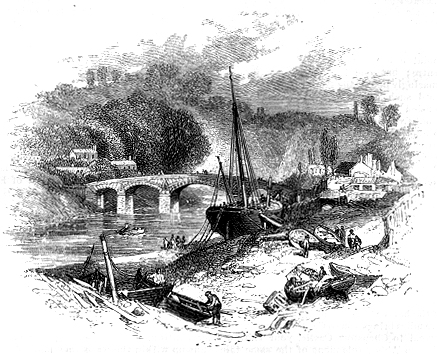|
|
On The Welsh Border.
by Wirt Sikes IN the days which reach back to the dot main of fable, and which so mingle history with poetry that it is bard to separate the rugged but respectable truth from delicious but disreputable falsehood, there was in the island which is now Victoria’s queendom a giant of the race of Ham. He was a son of Neptune Mareoticus, and a great tyrant, and Hercules slew him. His name was Albion, and this island was named after him. Subsequently Brutus, the grandson of Æneas, named it Britain after his own name, and Britain it was called until late hi the sixth century, Cambria being a part of it. In 585 the Saxons named Cambria Wales, and the boundaries thereof remained undisturbed throughout the succeeding thousand years, mostly devoted to hard fighting. The river Wye, from its mouth at the town of Chepstow to the little village of Redbrook, fourteen miles straight north, forms this ancient boundary line between the Welsh domains and the English. On reaching Redbrook the river turns its back on Gloucestershire and the English, and goes winding into Herefordshire and the Welsh heart again, across the green and golden plains, and over the far-off hills up to its source among the crags of Plinlimmon. By driving over the iron bridge which at Chepstow spans the Wye — a graceful juvenile structure sixty years old-we pass out of Wales into old England. There is nothing in the aspect of things to tell the story. But the stories on one side the river were in the old days sacred in the eyes of the patriotic Cymry, while for those on the other side their scorn was measureless.  The Wye Bridge At Chepstow.
The border barons of Norman blood, who took possession of this region forcibly when William the Conqueror became King of England, were compelled to hem in the Welsh people by a chain of tremendous military castles. The Saxons were under a like necessity in their day, but the fortresses they erected to protect themselves from the Welsh were not very strong. They were usually of timber, with banks and palisades for further strength about the domestic offices, and a moat around all, with no other wall than the mound thrown up in digging it. These structures were not enough for the Norman lords marchers; in some cases they used the site of the Saxon fortress to build their stone castles on, but the site was all that had value to them. In order to keep what they had forcibly seized, they must intrench themselves in strongholds capable of defying the most terrific sieges, and which furthermore must be large enough to hold their families and retainers, as well as their warriors in enormous numbers. |
|
1
Books & articles appearing here are modified adaptations
from a private collection of vintage books & magazines. Reproduction of these pages is prohibited without written permission. © Laurel O'Donnell, 1996-2006.
|
|

